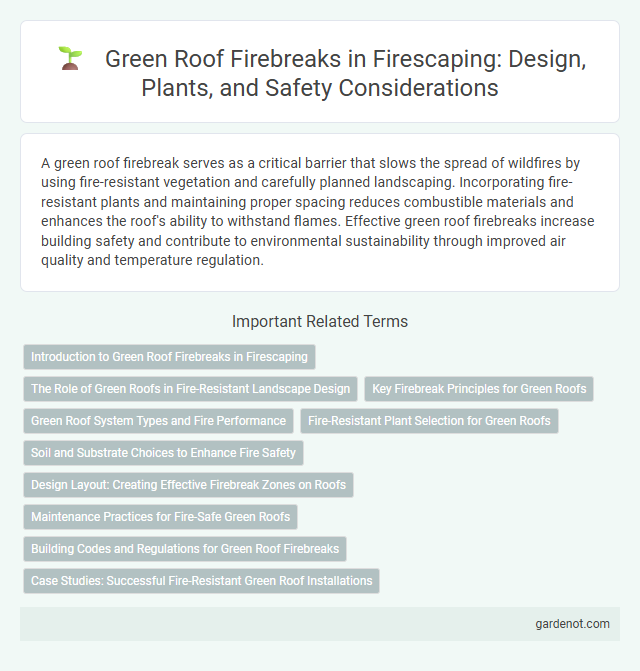A green roof firebreak serves as a critical barrier that slows the spread of wildfires by using fire-resistant vegetation and carefully planned landscaping. Incorporating fire-resistant plants and maintaining proper spacing reduces combustible materials and enhances the roof's ability to withstand flames. Effective green roof firebreaks increase building safety and contribute to environmental sustainability through improved air quality and temperature regulation.
Introduction to Green Roof Firebreaks in Firescaping
Green roof firebreaks are designed to prevent the spread of wildfires by incorporating fire-resistant vegetation and non-combustible materials on rooftops. These firebreaks minimize fuel availability, reducing the risk of fire ignition and propagation to the building structure. Effective green roof firebreaks integrate drought-tolerant plants and strategic spacing to enhance fire resilience in urban landscapes.
The Role of Green Roofs in Fire-Resistant Landscape Design
Green roofs act as effective firebreaks by reducing available dry fuel and retaining moisture, which slows fire spread and protects adjacent structures. Incorporating fire-resistant plants and non-combustible materials enhances their capacity to interrupt wildfire pathways. Strategic design of green roofs integrates vegetation layers and substrate depth to optimize fire resistance in urban landscape planning.
Key Firebreak Principles for Green Roofs
Key firebreak principles for green roofs emphasize the use of non-combustible materials such as gravel or fire-resistant tiles to create effective barriers that prevent fire spread. Maintaining vegetation with low flammability, including drought-tolerant succulents and fire-resistant plants, reduces fuel load and enhances fire safety. Regular clearance of dead plant matter and strategic spacing between vegetation patches optimize the green roof's role as a functional firebreak.
Green Roof System Types and Fire Performance
Green roof firebreaks are designed using various green roof system types, including extensive, semi-intensive, and intensive systems, each affecting fire performance differently. Extensive green roofs with drought-tolerant, low-flammability vegetation and low fuel loads typically provide superior fire resistance compared to intensive systems with dense, deep-rooted plants. Fire performance is enhanced by incorporating fire-resistant substrates, irrigation systems, and proper vegetation spacing to minimize fire spread across the green roof surface.
Fire-Resistant Plant Selection for Green Roofs
Selecting fire-resistant plants for green roofs significantly enhances the firebreak's effectiveness by reducing fuel load and slowing fire spread. Species such as sedums, succulents, and other drought-tolerant, low-flammability plants maintain moisture content and create natural barriers against flames. Incorporating fire-adapted native plants optimized for the local climate improves roof resilience, minimizes fire risk, and supports sustainable urban fire management.
Soil and Substrate Choices to Enhance Fire Safety
Selecting fire-resistant soil and substrates is crucial for creating an effective green roof firebreak, as materials with higher moisture retention and lower organic content reduce flame spread and ignition risk. Incorporating mineral-based soils such as expanded shale, clay, or slate improves thermal insulation and limits fuel availability, enhancing fire safety. Proper substrate depth and composition also support fire-resistant plant species, further mitigating fire hazards on green roofs.
Design Layout: Creating Effective Firebreak Zones on Roofs
Designing green roof firebreak zones involves strategically spacing non-combustible materials such as gravel, stone pavers, or sedum mats to interrupt potential fire pathways and reduce heat transfer. Careful layout planning includes creating continuous, wide firebreak strips that are integrated with drainage systems to maintain roof integrity during fire events. Optimizing the placement of these firebreak zones enhances rooftop safety while preserving the environmental benefits of green roofing systems.
Maintenance Practices for Fire-Safe Green Roofs
Regular maintenance of fire-safe green roofs involves removing dead vegetation, debris, and dry leaves to reduce combustible material and prevent fire spread. Irrigation practices are essential to maintain healthy, moisture-rich plants, which enhance the roof's fire resistance. Periodic inspections ensure plant diversity and density support effective firebreak functions, while trimming and pruning minimize fuel continuity across the green roof surface.
Building Codes and Regulations for Green Roof Firebreaks
Building codes and regulations for green roof firebreaks emphasize the use of non-combustible materials and specific fire-resistant plant species to mitigate wildfire risks. Standards such as the International Building Code (IBC) and local wildfire mitigation ordinances dictate minimum fire separation distances and vegetation management requirements. Compliance with these regulations ensures enhanced fire safety, reduces ember intrusion, and supports urban resilience against wildfires.
Case Studies: Successful Fire-Resistant Green Roof Installations
Case studies on green roof firebreaks demonstrate that fire-resistant materials such as non-combustible substrates and drought-tolerant succulent plants significantly reduce fire spread in urban settings. Successful installations in California and Australia highlight the effectiveness of layered green roof designs incorporating fire-resistant sedum species and inorganic growth media. Data from these projects reveal up to 60% lower fire ignition rates compared to traditional roofing, underscoring the potential of green roofs as strategic firebreaks in wildfire-prone areas.
Green roof firebreak Infographic

 gardenot.com
gardenot.com